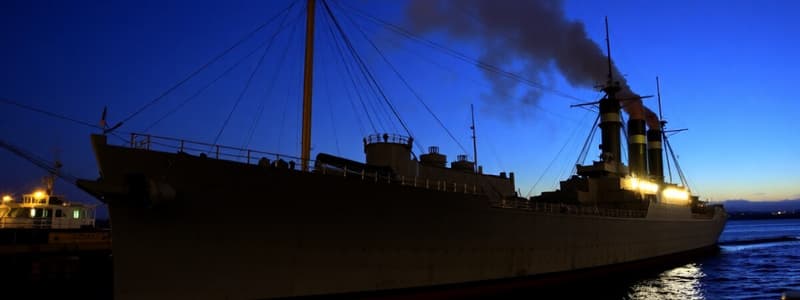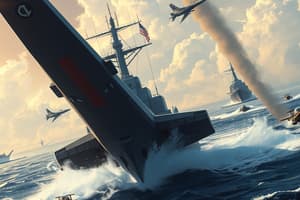Podcast
Questions and Answers
What was a significant factor that initially hindered the widespread adoption of steam power in the U.S. Navy after the Demologos?
What was a significant factor that initially hindered the widespread adoption of steam power in the U.S. Navy after the Demologos?
- Limited funding, coal storage limitations, and disagreements within the Navy. (correct)
- The superior speed and maneuverability of sailing vessels.
- International pressure to maintain traditional naval technology.
- The lack of skilled personnel to operate steam engines.
How did the Civil War influence the integration of steam power and modern ship design in the U.S. Navy?
How did the Civil War influence the integration of steam power and modern ship design in the U.S. Navy?
- It had little to no impact on naval technology.
- It led to a complete abandonment of traditional sailing ships in favor of ironclad steam-powered vessels.
- It created a demand for rapid naval expansion and innovation, accelerating the adoption of steam power and new designs. (correct)
- It demonstrated the ineffectiveness of ironclad ships, slowing down naval innovation.
What specific improvement did John Dahlgren make to steam engine technology for the U.S. Navy?
What specific improvement did John Dahlgren make to steam engine technology for the U.S. Navy?
- He invented a method for converting sailing ships into steam-powered vessels.
- He developed a new type of coal that burned cleaner and more efficiently.
- He adapted the French steam engine design, enhancing its reliability and safety. (correct)
- He created the first ironclad ship design.
Which event directly preceded the U.S. Navy's significant reinvestment in steam-powered warships and steel ships in the 1880s?
Which event directly preceded the U.S. Navy's significant reinvestment in steam-powered warships and steel ships in the 1880s?
What was the primary purpose of the 1869 directive issued by the Secretary of the Navy regarding ship power?
What was the primary purpose of the 1869 directive issued by the Secretary of the Navy regarding ship power?
What was the main reason the Demologos was considered more of an 'academic success' rather than a practical one?
What was the main reason the Demologos was considered more of an 'academic success' rather than a practical one?
What key feature characterized the Navy's first steel warships authorized by Congress in the years following President Arthur's address?
What key feature characterized the Navy's first steel warships authorized by Congress in the years following President Arthur's address?
How did the design and armament of the ironclad Monitor influence naval warfare?
How did the design and armament of the ironclad Monitor influence naval warfare?
Flashcards
Demologos
Demologos
First U.S. Navy steam-powered warship, launched in 1814.
Post-Civil War Naval Decline
Post-Civil War Naval Decline
Period of limited naval advancement due to financial and technological concerns.
1869 Navy Directive
1869 Navy Directive
Ordered all ships to be fitted with full sail power and justify any use of steam power.
President Arthur's Naval Plea (1882)
President Arthur's Naval Plea (1882)
Signup and view all the flashcards
Congressional Authorization (1883)
Congressional Authorization (1883)
Signup and view all the flashcards
Civil War Naval Innovation
Civil War Naval Innovation
Signup and view all the flashcards
John Dahlgren
John Dahlgren
Signup and view all the flashcards
Ironclad Monitor
Ironclad Monitor
Signup and view all the flashcards
Study Notes
- The U.S. Navy began experimenting with steam-powered ships as early as the War of 1812.
- Demologos, the first Navy steamer, was laid down on June 20, 1814.
- The Demologos successfully traveled 26 miles into open water during its sea trial on July 4, 1814, and fired one of its cannons.
- After its maiden voyage, the Demologos was laid up in the Brooklyn Navy Yard and used as a receiving ship until a gunpowder explosion sunk it.
- The Demologos was deemed an academic success, but not a practical one.
- Navy planners paid little attention to the steam engine in the twenty years after the Demologos' maiden voyage, causing slow progress with the new technology.
- Regular Navy warships started incorporating steam propulsion in the 1840s.
- The Civil War in the 1860s motivated rapid expansion and innovation of naval ships, leading to the first post-sail warships.
- The ironclad Monitor ushered in a new age for naval warships in design and armament.
- John Dahlgren adapted the French steam engine for the U.S. Navy, improving its reliability and safety.
- There was a sharp decline in investment in personnel and technology after the Civil War.
- Due to financial concerns over the cost of steam power, limited coal storage, a lack of coaling stations abroad, and disagreements between naval engineers and line officers, the Navy almost abandoned steel ships and steam power.
- In 1869, a directive from the Secretary of the Navy ordered that all ships "be fitted out with full sail power" and that any use of steam power must be justified by the ship’s commander.
- The Navy began rebuilding the fleet to reflect the era's technological achievements in the 1880s.
- In 1882, President Chester A. Arthur advocated for the Navy to Congress, stating, "Every condition of national safety, economy, and honor demands a thorough rehabilitation of the Navy."
- Congress authorized the construction of the Navy's first steel warships in the following year, which would be powered by steam propulsion and carry heavy guns on rotating turrets.
Studying That Suits You
Use AI to generate personalized quizzes and flashcards to suit your learning preferences.




